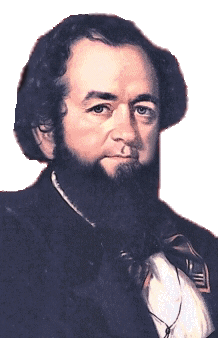Metropolitan News-Enterprise
Thursday,
July 8, 2004
Page
15
REMINISCING
(Column)
Tabasco: a Hot Sauce With an Uncertain Background
By
ROGER M. GRACE
On
tables and counters, in diners, seafood houses, and bars, there is that
ubiquitous cylindrical bottle with a narrow neck containing a crimson fluid.
The label reads, “Tabasco Sauce.” Though known by sight and by taste throughout
the world, there is probably no product on the market whose origins are
surrounded by more false, or at least unverifiable, lore.
Dedicating
efforts to separating fact from fantasy is historian/author Shane K. Bernard.
Since 1993, he’s been working for the McIlhenny Company, which manufactures Tabasco
Sauce. He’s found that some of the yarns of doubtful accuracy about the product
had been spread unwittingly through the years by the company, itself.
One
misstatement long propagated by the Avery Island, La., enterprise was
that founder Edmund McIlhenny began commercial distribution of his concoction
of peppers, vinegar and salt in 1868. Actually, Bernard told me last Friday, McIlhenny started marketing the product
in or about April of 1869. And while he did sell it in cologne bottles
(useful in promoting a dabbing rather than a pouring of the fiery condiment),
he used virgin containers, not discarded ones as the company had previously
recited.
|

|
EDMUND
McILHENNY
(1815-1890)
Uncertainty
surrounds the concoction by Edmund McIlhenny of Tabasco Sauce —
a condiment now produced, and marketed internationally, by his descendants.
The McIlhenny Company has hired an expert to undertake historical
detective work to separate fact from fiction about the product's
origin and development.
|
|
The
date was erroneously pegged at 1868, Bernard explained, based on a “misreading of
account books.”
Three
hundred fifty unused cologne bottles were filled with a brew made from peppers
harvested in 1868, Bernard said, but those bottles, he noted, were marketed
along with 308 others which were infused with sauce manufactured from peppers
harvested in 1869.
Whether marketing of the sauce commenced
in 1868 or 1869 is not a matter apt to have an impact on any of our lives. Nor
is the question of who supplied the seeds to McIlhenny for his first pepper
plants.
Yet,
I find utterly fascinating how the history of this familiar product has
apparently been mangled, and how the manufacturing company, owned by
descendents of the founder, has commissioned an historian to unravel the truth.
In progress is an investigation taking place more than a century-and-a-half
after the time when, according to most sources, the tale began.
That
beginning, traditional accounts declare, occurred when Friend Gleason, a United
States soldier in the War with Mexico (1846-48), brought dried pods back to
Louisiana from south of the border where he had fought, giving a small packet
to McIlhenny, a banker. The seeds from those pods are said to have spawned the
pepper plants which became the primary ingredient in Tabasco Sauce.
“I’ve
looked and looked for this Gleason person” in historical records, Bernard told
me, “and just can’t find him.”
As the long-told tale progresses…following
his 1859 marriage to Mary Avery and moving to Avery Island, McIlhenny planted
some of the seeds in his wife’s garden. McIlhenny and his family fled their
plantation in 1863 when Union soldiers stormed the area, seizing local salt
mines.
Upon
the McIlhennys’ return home in 1865 from Texas, they found their mansion had
been looted and their cane crops destroyed. But some (or, according to the more
dramatic version, one) of the pepper plants had survived, providing the seeds
for the first crop of Tabasco peppers.
Bernard
scoffed at the notion that McIlhenny obtained seeds in or about 1849 which had
simply lain around, not planted for nearly two decades.
Aside from the inherent improbability
of that having occurred, Bernard relies on family letters. Edmund McIlhenny’s
wife, eldest daughter, and brother-in-law, he related, told a different
version. Under it, the historian said, “an unnamed person gave Edmund the
peppers after the Civil War” while he was in New Orleans, the gift consisting
of five or six pepper pods.
The
donor, Bernard said, might have been a Confederate soldier. He disclosed that
in February, 1866, McIlhenny, who was “job-hunting in New Orleans,” wrote to
his wife, telling of having encountered a rebel soldier just returned from
Mexico, where he had fled rather than surrender.
It
was E.A. McIlhenny, second eldest son of Edmund McIlhenny and company president
from 1898-1949, who “believed the Friend Gleason story,” and caused the company
to adopt and disseminate it, Bernard said. He noted that it was “a common story
in all of our press kits.”
Does
Bernard totally discount that rendition? Well, if he ever did, he doesn’t.
Bernard
recently came across an article in an 1873 Louisiana newspaper in New Iberia,
close to Avery Island, which “implied that Edmund got the peppers during or
before the Civil War.” The information, he said, presumably came from Edmund
McIlhenny or someone close to him. That article “throws everything into doubt
again,” he remarked, adding: “I don’t know what to believe.”
A
further complication is the theory—which I’ll discuss next week—that one
Maunsel White originated Tabasco sauce, and that he gave McIlhenny the seeds
from which McIlhenny grew pepper plants used in a copycat concoction.
Copyright 2004, Metropolitan News Company
MetNews Main Page Reminiscing Columns
